What makes BRICS strong?
Economic and military might are powerful trump cards for any country to wield in the battle for influence. Yet the international pecking order is dictated ever more by the size of each country’s “soft power” toolbox, according to the conclusions of a survey by SKOLKOVO Business School – Ernst & Young Institute for Emerging Markets Studies (IEMS). Moreover, this is an area where the BRICS still lag far behind the leading Western powers.
Text by: Vladimir Volkov
On the morning of September 12, 2001, the people of America woke up in a very different country. The previous day’s attacks on the WTC’s Twin Towers in the heart of New York literally sent the collective consciousness of the world’s last superpower into a state of shock, throwing down a challenge that it would be unthinkable for that nation to ignore. In a matter of days, the world was confronted with a new concept: total war with the evil of global terrorism. For many years this concept was to remain the core imperative of all foreign policy crafted by the administration of President George W. Bush. It was under this ideological banner that the USA attempted to recruit allies for a new “crusade” to the key strongholds of international terrorism—roles which Washington elected to assign Iraq and Afghanistan. In doing this, America attempted to win the support of nations that were reluctant to add their names to the plans of the US-led coalition, which featured invasions of sovereign states in defiance of all applicable international norms.
George W. Bush gave a speech on terrorist threat, but it did not diminish the american “soft power”
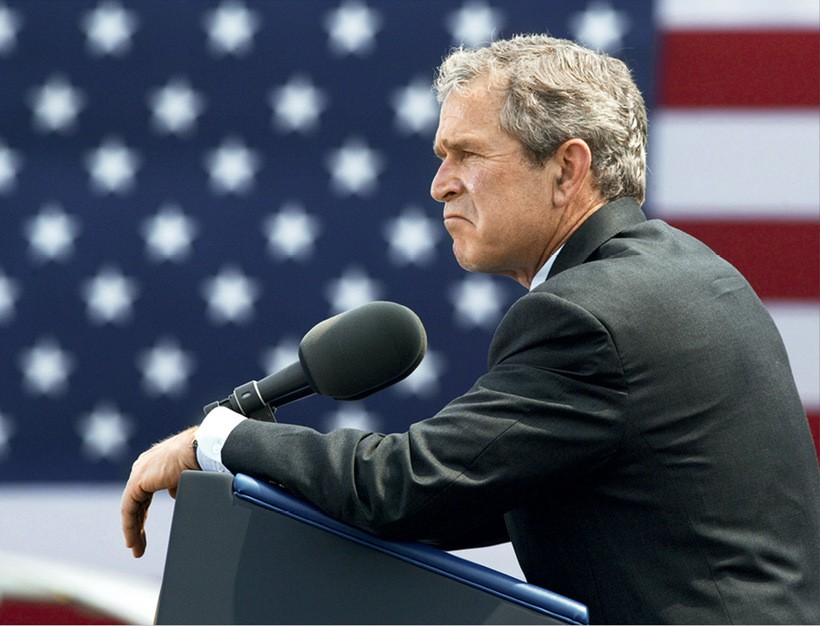 This new American ideologeme proved to be both highly convenient and relatively effective when it came to handling both states unwilling to join the alliance and targeted nations. To one American researcher, Associate Professor Janice Mattern of the National University of Singapore, this new ideology juxtaposed the “war on terror” (as a legal, just and morally justified act of self defense) against the illegal acts of the terrorists. The juxtaposition clearly served to highlight the “good, attractive” country of America, justly fighting its “pitiful and evil enemies”. This was actually a cunning trap that caught hesitant allies and enemies of America on the horns of a simple dilemma: “you are either with us, or with the terrorists”. The basic strategy was to assume that those willing to find themselves “on the dark side” would be few and far between, and even they would eventually rejoin the ranks of the “just and good”.
This new American ideologeme proved to be both highly convenient and relatively effective when it came to handling both states unwilling to join the alliance and targeted nations. To one American researcher, Associate Professor Janice Mattern of the National University of Singapore, this new ideology juxtaposed the “war on terror” (as a legal, just and morally justified act of self defense) against the illegal acts of the terrorists. The juxtaposition clearly served to highlight the “good, attractive” country of America, justly fighting its “pitiful and evil enemies”. This was actually a cunning trap that caught hesitant allies and enemies of America on the horns of a simple dilemma: “you are either with us, or with the terrorists”. The basic strategy was to assume that those willing to find themselves “on the dark side” would be few and far between, and even they would eventually rejoin the ranks of the “just and good”.
However, subsequent events showed that this strategy did not fully pay off. To a large degree, the responsibility for the failure lies squarely with the USA itself, given how it preferred to “shoot from the hip,” without waiting for a supportive political consensus to take shape. As a result, the wars in Iraq and Afghanistan dealt a heavy blow to America’s standing in the world, especially its image in the Moslem world, where the ideologeme “war on terror” was perceived as a “war on all Moslems” in the larger context of a “war of civilizations”. It should come as no surprise that after Barack Obama moved into the White House, the term “war on terror” vanished from the political lexicon in Washington, to be replaced by the more nebulous “overseas contingency operations”, indicating a change of ideological direction.
The end justifies the means
This is a sterling example of how an ideological concept, when enrobed in the necessary lexical clothes—such as the “war or terror”—becomes a powerful tool that can grant its holder (individual politicians or a whole state) the chance of getting his or her way without resorting to threats, or brute economic or military pressure. It was thanks to Joseph Nye, the famous American international relations expert and Dean of Harvard University’s John F. Kennedy School of Government, since the early 1990s such instruments and associated levers of influence have been called “soft power”.
Moreover, foreign policy that is reasonable and legitimate in the eyes of the “target audience” in the international community can be just one of a selection of instruments in an expansive soft power arsenal. Nye and other supporters of his theory also consider soft power to include national culture, political principles, the charisma of leaders, educational standards, technological achievement, sporting victories and even average life expectancy. In other words, soft power includes any and all of the numerous intangible assets that can enhance the attractiveness of a country in the eyes of the rest of the world, and which boost a nation’s ability to influence others and promote its own interests.
In order to better “sell” a country, one needs to enrobe it in packaging that is attractive to the “consumer”
Disregard for these instruments, or their mishandling, can make the achievement of national aims far more costly or even impossible, warns Nye, who served as Deputy Secretary of Defense in the Bill Clinton administration. Nye suggests that this gross overemphasis on deploying hard power partly explains US foreign-policy setbacks at the beginning of the last decade, culminating in America’s failure to gain international approval for its operation in Iraq. At that time, the administration’s position was dictated by Defense Secretary Donald Rumsfeld and Vice President Richard Cheney, who were convinced that retribution for 9/11 was a wholly sufficient justification for military intervention in that country, while the overthrow of Saddam and the export of democracy were self-justifying goals that required no consultation with the international community. Militant rhetoric, coupled with the failure to find weapons of mass destruction in Iraq—which was, formally, the grounds for the intervention—seriously tarnished America’s reputation and capped its soft power influence, explains Nye.
Soft-power brands
Experts claim that soft power is a trump asset in the modern world, a must-have for any country with long-term political interests. This is explained by the fact that, in the current era of globalization and burgeoning information technology, the image of any state—the way in which it is seen by the rest of the world—is manifested as a wholly tangible factor which, depending on the coloration of that image, can weaken or strengthen that state’s attractiveness and ability to wield influence. It is common knowledge that few today can boast an unblemished image. “Many countries suffer from image problems, caused both by deep internal changes in politics, economics and the social sphere, as well as external factors, due to the effect of outdated stereotypes,” explains Ying Fan of the Brunel Business School at Brunel University. “Strange as it may seem, huge gaps and barriers still block the path to mutual understanding between states and cultures, and this despite globalization, the development of international tourism, and modern technology, especially Internet-based technologies.”
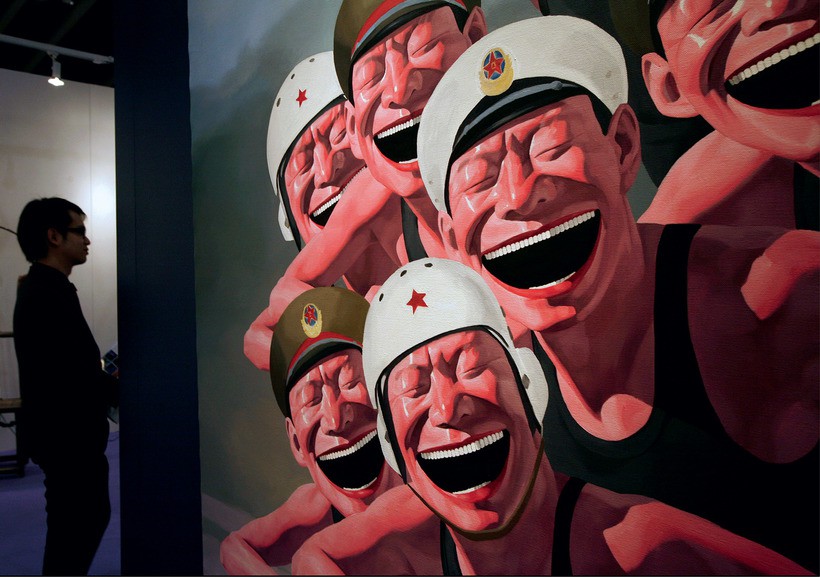
For example, developing countries and states with economies in transition suffer from low awareness of their brands, or negative images abroad. “These countries could have major sources of soft power, but they do not possess adequate resources (financial support and the necessary know-how) to realise that potential,” adds Ying Fan.
Recently, governments across the world have gained a better understanding of the need to “tell the story” of their nation to an international target audience. Moreover, they are doing this not as primitive, one-dimensional propaganda, as has traditionally been the case, but with subtlety and elegance. “Nation branding” success stories, according to the experts, reward that country with a competitive advantage in the broader international arena. One beneficial spin-off is greater attractiveness to foreign tourists and investors. “In essence, this is a practical application of branding and marketing communication strategies, designed to adjust the attitudes of foreigners to a specific country,” explains Ying Fan.
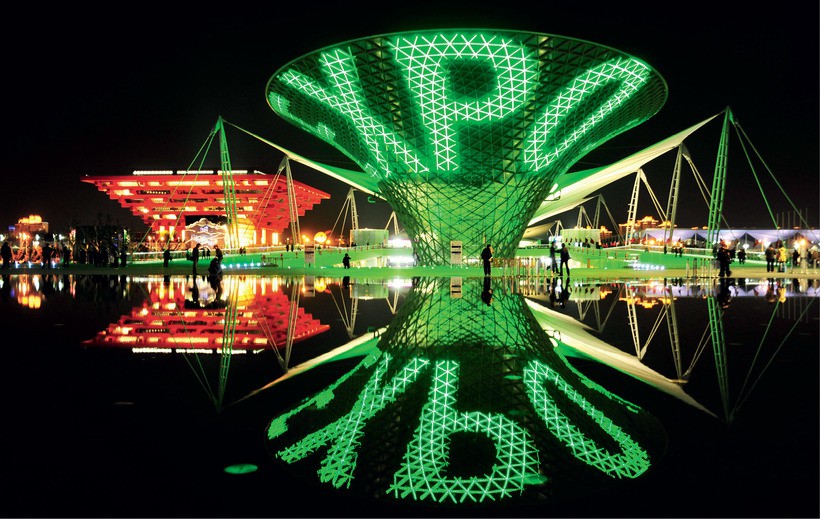
It is entirely logical, posits Nye, that the criteria for successful application of soft power in many ways coincide with the criteria for effective advertising and PR; just like any commodity, in order to better “sell” a country, one needs to enrobe it in packaging that is attractive to the “consumer”. Wally Olins, one of the pioneers of branding, founder of Wolff Olins and co-founder of Saffron Brand Consultants, agrees: “The modern world is ever more reminiscent of a gigantic stage, on which countries compete with one another for attention and influence. Nation branding is a key element, that is vital for victory in the global “beauty contest”. There is no substitute for consciously building a national brand.”
As the economies of nations strengthen and expand, it inevitably becomes necessary to replace the old image, no longer commensurate with the country’s new status, by using “rebranding”, notes Olins. For example, in the 1980s Spain and South Korea went through a similar stage, and in the early 1990s the People’s Republic of China joined the struggle for a new image—China is now trying to repeat this success, in part by hosting such global events as the 2008 Olympic Games in Beijing and Expo-2010 in Shanghai.
“A successful national branding campaign can help a country create a more favourable image in the eyes of an international audience, and in so doing develop even more deeply its soft power,” adds Ying Fan. However, in order to translate soft power from a potential source of influence into an actual, deployable tool, a host of conditions must be met. Amongst these is the imperative to possess a competitive culture industry and media infrastructure: this is the showcase in which national branding can take place. Fan also notes that before the cultural products of any given country can become a tool of soft power, they must be internationalised.
World Expo 2010 in Shanghai saw record attendance with leaders of various countries among guests
Quantifying power
In any case, experts tend to believe that in the future soft power will become ever more important for every country: in a world where the use of hard power ever more frequently produces the opposite of the intended result (an example of this is the recent “Arab Spring”), soft power is now seen as an important and universal tool, as well as an indicator of the strength of a state.
This is particularly germane for countries with fast-expanding markets, and which have supersized their military and economic potential over the last two decades. But has their soft power been similarly upgraded? If so, then has that influence reached sufficient levels for the economies of such high-growth countries to compete with the developed nations of the world?
Until recently, attempts to measure soft power were undertaken exclusively as a part of research efforts studying a large set of countries, by analysing public opinion or expert assessments. However, in the absence of an unbiased quantitative index based on reliable data such assessments have depended on transient impressions that can change overnight, as a function of the current geopolitical situation. One attempt to answer these questions by creating a quantitative index accurately reflecting the soft power of states was made by IEMS. This effort culminated in the publication by IEMS, in February of this year, of a soft power index for countries with rapidly developing markets.
The authors of the study identified 13 variables that influence the international soft power of sovereign states on the global scale, and which were then used to calculate scores over a period of five years, from 2005 to 2010. For a more precise understanding of the main factors behind soft power, and to highlight how countries have accumulated soft power, the variables were grouped into three categories.
The first of these is the global image, defined as the level of popularity and respect enjoyed by the country and, especially, its culture, across the world. “Countries commanding particular respect in the world have far greater influence by virtue of their soft power,” reports the IEMS study. The variables selected to calculate soft power include the volume of media products exported by the country, the popularity of the language, the number of Olympic medals won, the number of citizens of that country on Time Magazine’s List of the Most Influential People in the World, and the level of representation in Fortune Magazine’s ranking of the World’s Most Admired Companies.
The second category is global reputation, which is predicated on the degree to which any given country upholds universal moral and ethical principles.
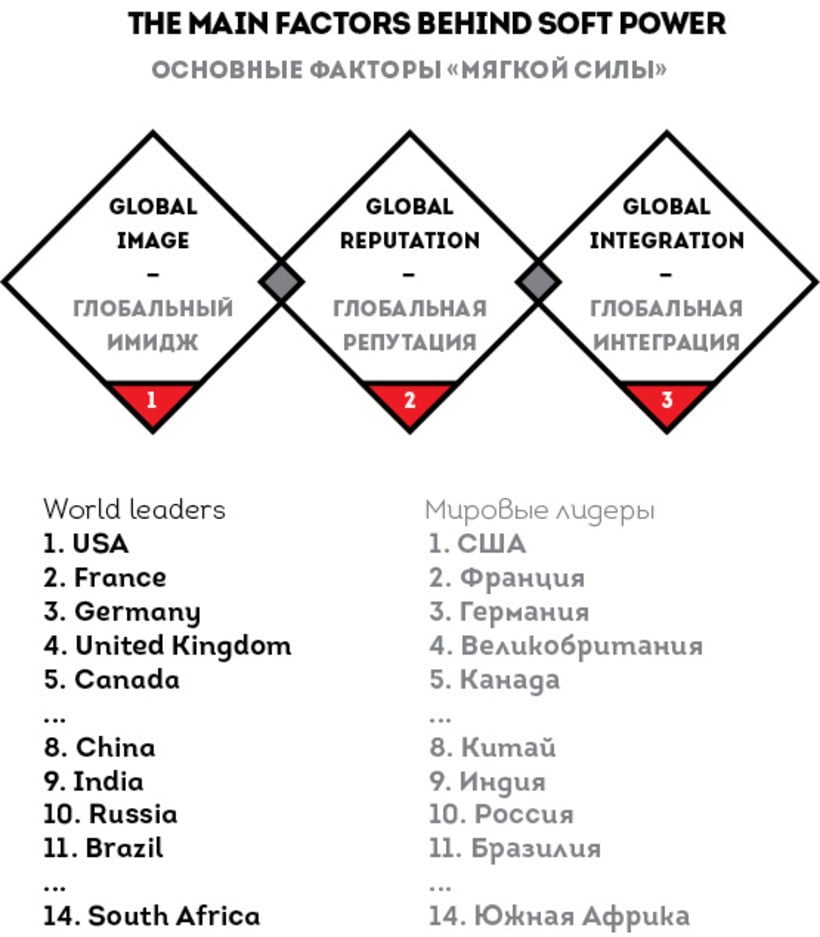 “The world respects states that protect their citizens, that support political and social freedoms, that guarantee civil rights and that treat their neighbours with respect. Countries with poor reputations do not enjoy the respect of the rest of the world and encounter difficulties when developing their soft power,” explain Peter Johansson and William Wilson of IEMS. For this category, the researchers used the country’s rating on the Freedom House Index, the level of elector activity and the volume of greenhouse gas emissions.
“The world respects states that protect their citizens, that support political and social freedoms, that guarantee civil rights and that treat their neighbours with respect. Countries with poor reputations do not enjoy the respect of the rest of the world and encounter difficulties when developing their soft power,” explain Peter Johansson and William Wilson of IEMS. For this category, the researchers used the country’s rating on the Freedom House Index, the level of elector activity and the volume of greenhouse gas emissions.
Finally, the third category is “global integration” – a reflection of how closely the country interacts with the rest of the world. “The number of people that travel to the country as tourists, as students or to take up residence, and the ability to interact with the outside world, are determined by the country’s links with the international community and consequently, its options for rendering influence,” consider the experts at IEMS. In order to calculate the contribution of this category to the index, the volumes of inbound immigration and tourism are taken into consideration, the positions of universities in international rating lists, and the portion of the population that speaks fluent English—the language of international communication.
BRICS on the heels of US
So, what are the results of this assessment? Predictably, the upper echelons of the soft-power monger shortlist are dominated by the G7, with one unchallenged champion far in the lead: the USA. Although everyone knows that America’s reputation has taken some heavy hits (the country is universally considered to be the key culprit behind the world financial crisis, not to mention the conflict in Iraq during the period under study); strange as it may seem, these difficulties have not greatly affected the quantitative assessment of the county’s soft power. Thus, in the 2010 index, the USA scored a total of 87 points, a full 37 points ahead of the next best contender, France. Since 2005, America has gained three points. “These results unequivocally indicate that America’s soft power remains dominant and uncontested across the world,” note Johansson and Wilson. The key reasons for the high US score are immigration, the rating of American universities, and royalties from the export of media products, which have given this country the greatest soft-power boost.
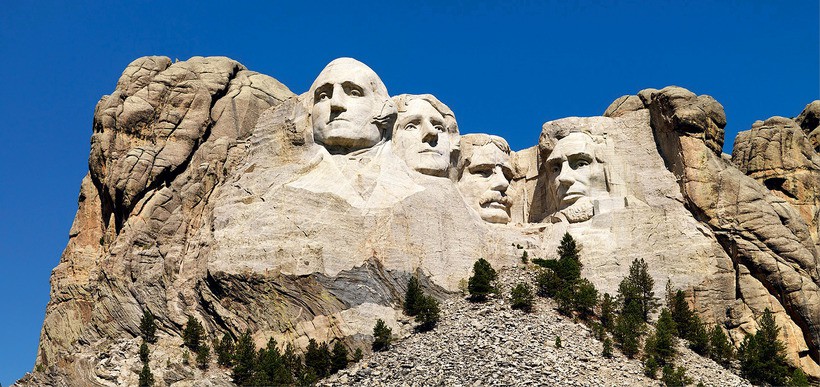
A large part of America’s soft power is derived from its colossal size, as the sheer scale of the country multiplies its advantageous properties. A similar advantage is possessed by China, which boasts the largest soft power of all the BRICS countries, and is biting at the heels of the G7 in the IEMS ratings. Moreover, unlike the USA, China scored extremely low for “openness” and “political freedom”. “Unlike other rapidly developing economies, including India, China’s soft power is almost exclusively a function of its economic might,” reports the study. The Middle Kingdom’s dominance of the list of World’s Most Admired Companies is also dubious, considering that this variable is mainly determined by the rapid expansion of its monolithic state-owned companies.
although everyone knows that America’s reputation has taken some heavy hits, these difficulties have not greatly affected
The most important component of India’s soft power, which is second among the BRICS, is knowledge of English, an advantage that endows numerous Indian diasporas with a unique advantage in the West. According to existing data, about one third of Silicon Valley start-ups were created by Indian nationals, suggesting that these achievements would have been impossible without them. The second-largest contributor to India’s index is the tangible presence of nationals of that country in the Time 100 list. Meanwhile, low levels of voter activity, weak university ratings and the comparatively low attractiveness of the country for tourists, due to the omnipresent poverty of the population and poorly developed infrastructure, are all factors undermining India’s soft power.
Russia, which had the third-largest soft power amongst the BRICS countries in 2010, can be predominantly thankful to migration for this feat – essentially that of ethnic Russians from the countries of the CIS, who are together responsible for approximately one quarter of the total Russian score. “Russia’s problem is an acute lack of diversity in its soft power base. This makes it quite unlike India and China, which have comparatively high scores in four or five different categories,” write IEMS researchers.
The difference between soft and hard power is not self-evident. But it is actually far harder to utilise the first one than the second
In that Russia has consistently low scores for areas such as fluency in English, interest in the Russian language amongst foreign students, and presence in the list of most admired companies. It is therefore no surprise that Russia’s “freedom” score is significantly lower than the average level, although the score for “rule of law” is somewhat higher. For the 2005–2010 period as a whole, Russia’s soft power score fell by five points—the second-largest drop of this sort amongst the rapidly developing economies taking part in the study. The main reasons for this were: a smaller number of Russians in the Time 100 list, major shrinkage in the ratings of Russian universities, and diminished Olympic track record.
Unlike Russia, Brazil managed to leap ahead in the emerging markets list over the same period, jumping from sixteenth place to eleven. Voter turnout, political freedom, media royalties and Olympic medals in this country were all well above the average for a country with a rapidly emerging market.
Finally South Africa, the last member of the BRICS club in the IEMS list, slipped down three positions over the five years, mainly due to a weak presence in the Time 100 and total absence from the Most Admired Companies list.
Nothing but an illusion
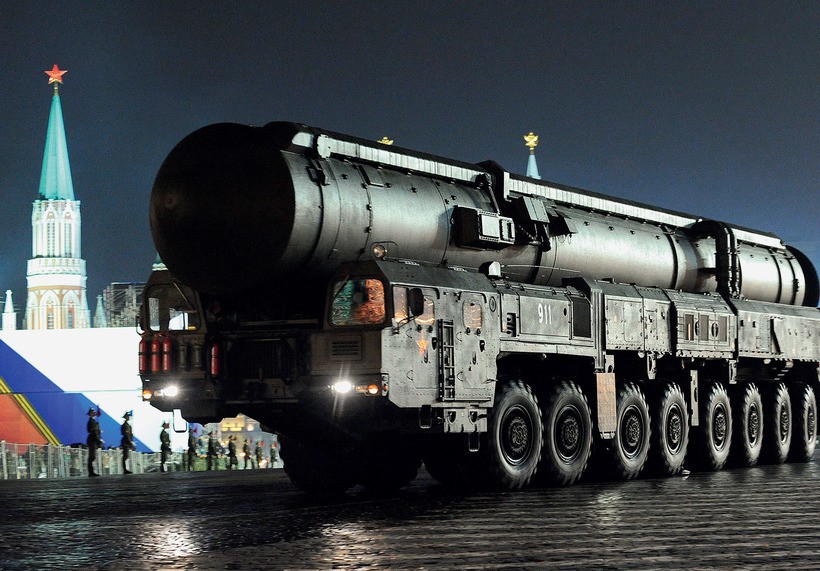
Topol-M mobile launcher demonstrates power of modern russia, which rocketed to the ranks of world’s top emerging markets
The BRICS countries, clearly, have a long way to go before they can stand level with Western states in terms of their soft power, enjoying a comparable level of influence in the world. On the other hand, this task could turn out to be a lot easier than it first appears to be. While new achievements in foreign language studies, building powerful democratic institutions and universities are important, the greatest potential may lie elsewhere. The solution could be in the ambiguity of the concept of soft power, which, as Joseph Nye himself accepts, is often hard to clearly distinguish from hard power. This is an opinion shared by many. “The difference between soft and hard power is actually not self-evident. Many believe that soft power is more effective, and can be instrumentalised for greater results. This may all be an illusion, because it is actually far harder to utilise soft power than it is hard power,” explains Ying Fan. This is also fully confirmed by the results of the IEMS research, which identifies a clear correlation between the levels of soft and hard power across the list’s top ten. Moreover, all these states continue to actively invest in the development of hard power, primarily by the record-breaking expansion of military spending, and the volume of this investment significantly exceeds investments into soft power instruments. Russia, which plans to modernise its armed services, spending $730bn over ten years, is no exception to the rule. “I think that in the eyes of the current Russian leaders, the need to reinforce the military primarily flows from the international positioning of the country, given the prospects for development,” writes Sergei Karaganov, a well-known political scientist, in an article in Vedomosti newspaper. “Military build-up is intended to compensate for the relative weakness of the other factors of national strength: the economy, the technological sector, even the national psychology and national ideas.” It is therefore possible that in a relatively short time the novel concept introduced by Joseph Nye may lose its current popularity, and in the public eye soft power may be relegated to the role of a mere delicate sidekick to the good old hard power.










